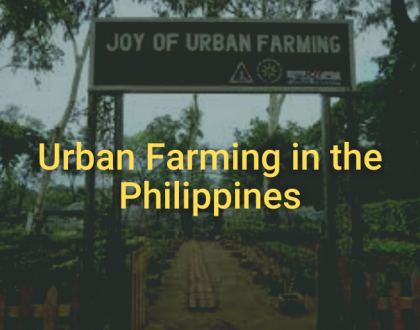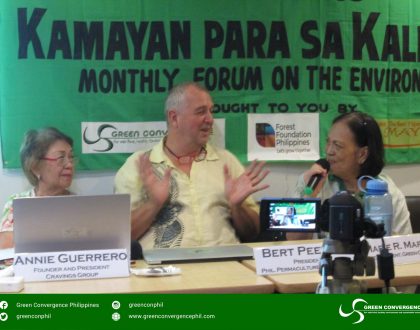Organic Agriculture
Thank you for inviting me to participate in this event. I also convey the greetings of Archbishop Antonio Ledesma for the success of this undertaking and in the conduct of an objective social audit process of our concerns about the environment.
When Nina invited me to chair this session, I told her that I am not an expert on organic farming; but Nina said “don’t worry, just give an overview and help facilitate the discussions. There will be a
roomful of experts in attendance who will take care of the rest.” And those experts, my friends, are you. Before we start, may I propose the context of our deliberations today?
First, we are told that about 55 million years ago, in an event known as the Paleocene-Eocene Thermal Maximum, a series of extreme global warming released massive carbon dioxide estimated at about 60,000 billion metric tons over thousands of years and it took a period of over 100,000 years to remove the excess from the atmosphere. Mother Earth survived but all or almost all life did not. In other words, whatever happens and whatever we do or not do, Mother Earth will ultimately survive. It is us and those who will come after us who will not. Of course we will do everything we can to spare Mother Earth the pain and injury of our making and will join and lead, if possible, the voices of other developing countries for international solidarity in the right solutions.
However, and this is my second point, as a lay observer of the processes and outcomes of international negotiations on economic and legal issues and now on climate change, I hope that those who went to Paris will not take offense when I say that I do not believe there is much to celebrate yet in the recent Paris talks. And that eventually, short- term national self-interest in a world of gross inequalities in power and wealth, will trump the longer-term general welfare of humanity. And when self-interest is rationalized with self-righteousness, it is even more difficult to overcome as we know from our own underperformance at human development and social change in our country.
Third, I submit that since global warming is a reality that sooner or later will result in dire consequences to the world in the likely event of a failure of international solidarity, as stewards of God’s creation in our part of the world, to carry out that responsibility in the best interests of our own country with the greatest caring for those who cannot protect or defend themselves. That is after all, is what social justice is all about. In that regard, we may have a chance at national solidarity since the rich and the powerful have experienced
the direct effects of climate change in common with the poor and may see national interest as also their own. In other words, by upholding their identity more than their self-interest, who knows, by successfully working together to mitigate and adapt to climate change, we may open the doors to addressing not just its direct effects but the systemic causes that also stand in the way of the radical social change we promised the poor so that we can finally put things right in our country.
It is in this context that I hope we will talk about organic agriculture today. The articulated objectives of organic agriculture are among the deepest concerns of the Green Convergence Coalition and are the standards to which we can hold accountable not just the present and succeeding governments, especially the Department of Agriculture and the NOAB (National Organic Agriculture Board), but also ourselves, namely:
a. Better farm income and sustainable livelihood—Increased farm productivity, reduced expenses on imported farm inputs, better income for farmers, and reduction of poverty in the rural sector;
b. Improved Health—Protected health for farmers, consumers, and the public in general;
c. Environmental Protection—Enhanced soil fertility and farm biodiversity, reduced pollution and destruction of the environment, as well as prevention of further depletion of natural resources;
d. Disaster Risk Reduction and Resilience to Climate Change—Improved resiliency to disaster risks through diversification and less exposure to external inputs; and
e. Social Justice—Meeting the basic material needs and improving standard of living for all, upholding human rights, gender equality, labor standards, and the right to self-determination.
The Secretariat of the NOAB kindly briefed me on the program and I have asked that their powerpoint presentation and some other materials provided me be distributed to all the participants in our workshop today. I hope you got them and were able to familiarize yourselves with the official version of its history, objectives, the budgets since 2010, status of the programs and accomplishments to date, and its challenges, so I don’t have to dwell on these in detail. The new director of the program is also here today and can answer questions later.
I hope that those of you who may have a different appreciation from the official version of the facts, the issues and challenges ahead will share these with us during the deliberations so that we can have a balanced outcome report on this Summit.
After the passage of the law in 2010, the National Academy of Arts and Sciences, being the advisory body for science and technology policies and issues held a Round Table Conference to assess its status in the country. One of the papers1 that came out of this and the follow-up discussions had this to say about the state of organic agriculture in our country today which is a good frame for our discussions:
“Organic agriculture in its present state is still far from its full potential. Given the meager formal support throughout its supply chain, including input
1 How Sustainable Is Organic Agriculture in the Philippines? By Rodel G. Maghirang et al (Trans Nat Acad Sci & Tech (Philippines) Vol 33 (no. 2) ISSN 0115-8848)
supply, production and Research and Development on seeds, nutrient and pest management. Thus, direct comparison of organic agriculture with conventional agriculture does not appear to be valid. Overall, it is well accepted that organic agriculture is sustainable on the ecological aspect but sustainability on the financial and the social/cultural aspects are still being questioned. There is optimistic prognosis for organic agriculture, but the numerous challenges of agronomic, economic and cultural nature must be addressed more substantially. This would require long-term, support for research institutions, a strong extension system and a committed public in sharing with the costs of organic agriculture given its multi- functionality benefitting everyone.”
In the light of this assessment from experts, that is our task today. May I start it off with some preliminary questions to the experts in the room?
First: The target is to develop organic farming to five percent (5%) of our total agricultural lands or roughly 483,450 hectares, of which around 151,000 hectares, as of January 15, 2016, are already in place. If organic agriculture is the future of food security, competitiveness and sustainable agriculture, why is the target so small? Moreover, since the selected sites are primarily rooted in the private initiatives of farmers since the 1980s, the question is: Have these been validated in the light of later knowledge such as on vulnerabilities of the sites to climate change? Water needs of Organic Agriculture (OA)?
Second: Is the model we want to propagate that of small farms selling to their local communities? This is consistent with the findings of the IFAD (International Fund for Agricultural Development) that the future of global food security is some 450 million small farms of less than 2 hectares each in the world. That is also the model of our agrarian reform program with certain admissible permutations like cooperatives to address economic scale considerations.
Third: How important is the expensive 3rd party certification in the domestic market, of which there are only 46 farms and establishments covering 1,212 hectares, since government subsidy is only planned for 3 years?
Fourth: What are the nutritional advantages of organic agriculture and are these sufficient to justify the price differential between organic and non-organic products? Are the prices today of organic products within the reach of the non-farmer poor? Is it possible to put organic products within their reach as factors like regenerated soil and supply chain inputs materialize?
Fifth: Are the organizational and operational challenges that have arisen since 2010 being addressed? Delays in implementing guidelines, issues of continuity and institutional memory (6 heads in 5 years of the Secretariat, 11 out of 12 of its staff are contractual and co-terminus with the president).
Is there convergence with the DENR and the DAR and its 2.7 million farmer beneficiaries of which about half are not in Agrarian Reform Communities (ARCs)? Is there a political commitment at the LGU level and do they have the capable extension workers to carry it out?
Recommended Posts

Environmental Forum: ‘Kailangan pa rin ang green spaces sa urban area’
November 23, 2020

2nd Philippine Environment Summit 2018 (Cebu) Progress Reports
August 06, 2018

